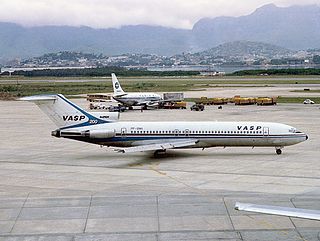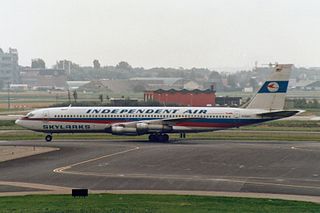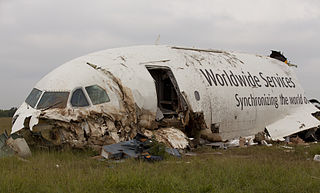
Pan Am Flight 759 was a regularly scheduled domestic passenger flight from Miami to San Diego, with en route stops in New Orleans and Las Vegas. On July 9, 1982, the Boeing 727 flying this route crashed in the New Orleans suburb of Kenner after being forced down by a microburst shortly after takeoff. All 145 on board and 8 people on the ground were killed. The crash had the highest number of aviation fatalities in 1982.

China Airlines Flight 676 was a scheduled international passenger flight. On Monday, 16 February 1998, the Airbus A300 jet airliner operating the flight crashed into a road and residential area in Tayuan, Taoyuan County, near Chiang Kai-shek International Airport, Taiwan.

United Airlines Flight 389 was a scheduled flight from LaGuardia Airport, New York City, New York, to O'Hare International Airport, Chicago, Illinois. On August 16, 1965, at approximately 21:21 EST, the Boeing 727 crashed into Lake Michigan 20 miles (32 km) east of Fort Sheridan, near Lake Forest, while descending from 35,000 feet mean sea level (MSL). There was no indication of any unusual problem prior to impact.

American Airlines Flight 383 was a nonstop flight from New York City to Cincinnati on November 8, 1965. The aircraft was a Boeing 727, with 57 passengers, and 5 crew on board. The aircraft crashed on final approach to the Cincinnati/Northern Kentucky International Airport located in Hebron, Kentucky, United States. Only three passengers and one flight attendant survived the crash.
The article describes accidents and incidents on Korean Air and its predecessor companies Korean National Airlines and KAL. Korean Air had many fatal accidents between 1970 and 1999, during which time it wrote off 16 aircraft in serious incidents and accidents with the loss of 700 lives. The last fatal accident, Korean Air Cargo Flight 8509 in December 1999 led to a review of how Korean cultural attitudes had contributed to its poor crash history. Since then safety has improved.

Scandinavian Airlines System Flight 933 was a scheduled international flight from Denmark to the United States that on January 13, 1969, crashed into Santa Monica Bay at 19:21, approximately 6 nautical miles (11 km) west of Los Angeles International Airport (LAX) in California, United States. The crash into the sea was caused by pilot error during approach to runway 07R; the pilots were so occupied with the nose gear light not turning green that they lost awareness of the situation and failed to keep track of their altitude. The Scandinavian Airlines System (SAS) aircraft had a crew of nine and 36 passengers, of whom 15 died in the accident. The flight originated at Copenhagen Airport, Denmark, and had a stopover at Seattle–Tacoma International Airport, where there was a change of crew. The crash was similar to Eastern Air Lines Flight 401. The crash site was in international waters, but the National Transportation Safety Board carried out an investigation, which was published on July 1, 1970. The report stated the probable cause as improper crew resource management and stated that the aircraft was fully capable of carrying out the approach and landing. The aircraft was conducting an instrument approach, but was following an unauthorized back course approach.

VASP Flight 168, a Boeing 727-212, serial number 21347, registered PP-SRK, was a scheduled passenger flight from São Paulo to Fortaleza, Brazil which, on June 8, 1982, crashed into terrain while descending into Fortaleza, killing all 137 people on board.

Indian Airlines Flight 605 was a scheduled domestic passenger flight from Mumbai to Bengaluru. On 14 February 1990, an Airbus A320-231 registered as VT-EPN, crashed onto a golf course while attempting to land at Bangalore, killing 92 of 146 people.

On 8 February 1989, Independent Air Flight 1851, a Boeing 707 on an American charter flight from Bergamo, Italy to Punta Cana, Dominican Republic, struck Pico Alto while on approach to Santa Maria Airport in the Azores for a scheduled stopover. The aircraft was destroyed, with the loss of all 144 people on board, resulting in the deadliest plane crash in Portugal's history. All of the passengers on board were Italian and all of the crew were Americans. The crash is also known as "The disaster of the Azores".

Alaska Airlines Flight 1866 was a regularly scheduled passenger flight operated by Alaska Airlines from Anchorage, Alaska, to Seattle, Washington, with several intermediate stops in southeast Alaska. The aircraft was a Boeing 727-100 with U.S. registry N2969G manufactured in 1966. On September 4, 1971, the aircraft operating the flight crashed into a mountain in Haines Borough, about 18 miles west of Juneau, Alaska while on approach for landing. All 111 people aboard were killed. The subsequent investigation found that erroneous navigation readouts led the crew to descend prematurely. No definitive cause for the misleading data was found. It was the first fatal jet aircraft crash involving Alaska Airlines, and remained the deadliest single-aircraft accident in United States history until June 24, 1975, when Eastern Air Lines Flight 66 crashed.

Flying Tiger Line Flight 66 was a scheduled international cargo flight from Singapore Changi Airport, to Hong Kong's Kai Tak Airport via a stopover at Kuala Lumpur International Airport, Malaysia. On February 19, 1989, the FedEx-owned Boeing 747-249F-SCD crashed while on its final approach. The aircraft impacted a hillside 437 feet (133 m) above sea level and 12 kilometres from Kuala Lumpur, resulting in all four crew members being killed.

TAME Flight 120 was a Boeing 727-134 airliner, registration HC-BLF, named El Oro, operating as a scheduled international passenger flight between Quito, Ecuador and Cali, Colombia, with a scheduled stopover at the Ecuadorian border town of Tulcán. The aircraft crashed while on approach to Tulcán's Teniente Coronel Luis A. Mantilla International Airport on January 28, 2002. The pilot flew the approach incorrectly in reportedly foggy conditions, and the aircraft crashed into the side of the Cumbal Volcano, located near Ipiales, Colombia, at 10:23 in the morning. All passengers and crew were killed in the crash.
Air France has been in operation since 1933. Its aircraft have been involved in a number of major accidents and incidents. The deadliest accident of the airline occurred on June 1, 2009, when Air France Flight 447, an Airbus A330-203, crashed into the Atlantic Ocean with 228 fatalities. A selected list of the most noteworthy of these events is given below.

ADC Airlines Flight 86 was a Nigerian domestic flight operated by ADC Airlines from Port Harcourt to Lagos. On 7 November 1996 the crew of the Boeing 727-200 operating the flight lost control of the aircraft while avoiding a mid-air collision on approach; the aircraft crashed inverted at a very high speed, killing all 144 passengers and crew on board. Investigators determined the primary cause of the accident was an air traffic control error.

UPS Airlines Flight 1354 was a scheduled cargo flight from Louisville, Kentucky, to Birmingham, Alabama. On August 14, 2013, the Airbus A300 flying the route crashed and burst into flames short of the runway on approach to Birmingham–Shuttlesworth International Airport. Both pilots were pronounced dead at the scene of the crash. They were the only people aboard the aircraft. It was the second fatal air crash for UPS Airlines.

Iberia Airlines Flight 933 was an international flight from Madrid Barajas International Airport bound for its destination, Boston-Logan International Airport in Boston, that suffered a runway incident on December 17, 1973. As the McDonnell Douglas DC-10, the aircraft operating the flight was approaching the airport, it collided with the ALS system 500 feet short from the runway threshold. This critically damaged the frontal gear, collapsing it. The aircraft came to a rest 300 feet before the runway. Although all 168 onboard survived, the plane was written off. This accident was the first hull loss of the DC-10.

Atlas Air Flight 3591 was a scheduled domestic cargo flight operating for Amazon Air between Miami International Airport and George Bush Intercontinental Airport in Houston. On February 23, 2019, the Boeing 767-375ER(BCF) used for this flight crashed into Trinity Bay during approach into Houston, killing the two crew members and one passenger on board. The accident occurred near Anahuac, Texas, east of Houston, shortly before 12:45 CST (18:45 UTC). This was the first fatal crash of a Boeing 767 freighter.

FedEx Express Flight 1478 was a scheduled domestic cargo flight from Memphis International Airport to Tallahassee International Airport. On July 26, 2002, the Boeing 727-232F aircraft flying this route crashed during landing at Tallahassee. All three flight crew members survived the accident with serious injuries, but the aircraft was destroyed.
















